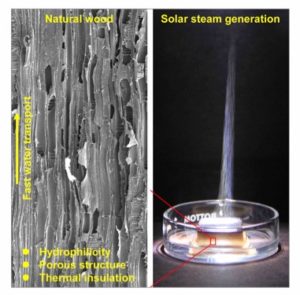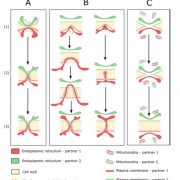Using natural wood as a cost-effective alternative in solar steam generation
 Using solar irradiation effectively for steam generation is a promising renewable energy source for a wide variety of applications, including large-scale power generation, desalination, water purification and sterilization, which is particularly important in remote areas where solar power is often the only reliable or available energy source. Traditional methods of solar steam generation are ineffective and lead to energy loss since it is based on heating large volumes of liquid to high temperatures. Avenues to improve solar steam generation is a subject of great interest, and porous receivers and nanofluids have been proposed to reduce losses. A renewable material of current interest is wood, which consist of a rich mesoporous structure, vertically aligned microchannels and an interconnected bordered pit system for highly effective water transport. A recent study investigated the efficiency of carbonised wood of various tree species for application in solar steam generation devices. The researchers followed a simple one-step, cost-effective procedure, carbonising the top surface of wood samples, and measured the densities, porosities, and thermal conductivities of the samples, important properties for steam generation devices. Although this study was purely proof of concept, poplar wood indicated exceptionally effective steam conduction due to the high porosity, low thermal conductivity, and high light-capturing capability of poplar wood-based solar steam generation devices. Natural wood can, therefore, be used in many energy-water nexus applications, enhancing efficiency and reducing losses in a low-cost and sustainable way. (Summary by Danielle Roodt Prinsloo) Joule 10.1016/j.joule.2017.09.011
Using solar irradiation effectively for steam generation is a promising renewable energy source for a wide variety of applications, including large-scale power generation, desalination, water purification and sterilization, which is particularly important in remote areas where solar power is often the only reliable or available energy source. Traditional methods of solar steam generation are ineffective and lead to energy loss since it is based on heating large volumes of liquid to high temperatures. Avenues to improve solar steam generation is a subject of great interest, and porous receivers and nanofluids have been proposed to reduce losses. A renewable material of current interest is wood, which consist of a rich mesoporous structure, vertically aligned microchannels and an interconnected bordered pit system for highly effective water transport. A recent study investigated the efficiency of carbonised wood of various tree species for application in solar steam generation devices. The researchers followed a simple one-step, cost-effective procedure, carbonising the top surface of wood samples, and measured the densities, porosities, and thermal conductivities of the samples, important properties for steam generation devices. Although this study was purely proof of concept, poplar wood indicated exceptionally effective steam conduction due to the high porosity, low thermal conductivity, and high light-capturing capability of poplar wood-based solar steam generation devices. Natural wood can, therefore, be used in many energy-water nexus applications, enhancing efficiency and reducing losses in a low-cost and sustainable way. (Summary by Danielle Roodt Prinsloo) Joule 10.1016/j.joule.2017.09.011









